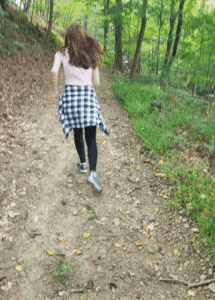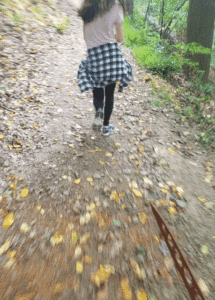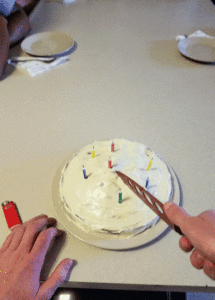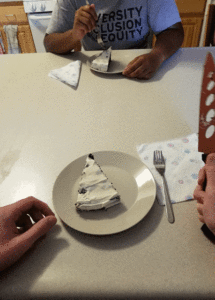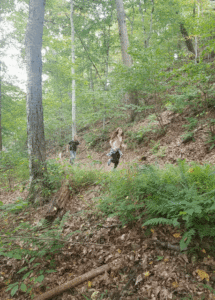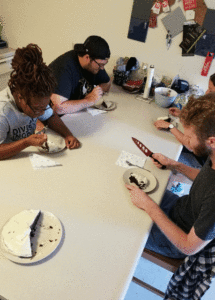Upon reading chapter 6, I was intrigued by the concept of designed and conceptual norms. As stated in the book, “a norm is an accepted behavioral pattern that’s learned and that helps within a specific culture or group.” To some people, having an all touch screen phone may be the norm whereas some may think phones with keyboards are. As technology advances, these norms continue to change at an extremely alarming rate. Designers are responsible for making subtle or dramatic changes designs that have the power to alter the way we use technology for years and years to come; all while keeping in mind usability, functionality, and likability. In today’s society, media norms change much faster than social norms do. Years ago, I would have never imagined being able to connect speakers wirelessly to any device in my house or have a fridge that allowed me to watch the news while I eat breakfast in the morning. Slowly yet surely, these things are becoming norms; in the near future, they’ll be nothing but old news. In the large scheme of things, it’s important to understand how crucial the role of the designer is when creating new media. Their ideas build our future and without them, we’d still be using cave drawings and sending carrier pigeons.
Thoughts on Chapter 6
I found several things about chapter six interesting, including how design is currently a “cultural backdrop” for our world. A designer chooses subtle decisions that can be seen as insignificant, but then can be amplified when sent out into society. Because of the time gap in-between designing a product, creating the physical version and mass producing, and sending out the product to users, it becomes difficult to map out a cultural shift to a specific design choice. I found the idea of amplification of a design decision interesting, because mass production causes identical objects to be sent out, the designers voice is then “multiplied.” The chapter also touched on invisible manifestation, and how there can be consequences to the things we use even though the changes in our lives are so subtle we don’t notice. (pg. 87)
I also agree that technology can be a positive force of change, but that potential has not been reached fully. The book talks about how even though this is true, it places digitization at the heart of the discussion for the future, instead of how we use that technology to create positive change and interactions. The book says “The digital age cannot be empowering without empowering someone.” The book goes on to give some specifics on this, including how cell phones have not helped us be more empathetic but have caused accidents, the internet hasn’t helped tensions with hate speech and talks of politics and religion, and it has not helped feed the hungry. But to solve these problems we have to understand what we’re trying to do with design and technology and design simply from there.( pg. 92)
The chapter also goes into a bit more detail on the negative impacts of technology in our own lives. I did not realize at first how much I look up things on google. Any question I need answered or word I don’t understand, I google. The book says this increased dependency on technology creates huge possibility, but also can lead to personal intellectual regression. Since most of us don’t even notice how present this is in our lives, as it slowly crept in on us, it affects a large number of people in an immediate fashion. This may be a long term road to disaster of not knowing things on our own when technology fails. (pg. 93)
Movie Response
Movie Response
Two big points really stuck out to me from the in-class movie: (1) Good design will make the object make sense and (2) good design is as little design as possible. When these points were presented, they went on to talk about Apple and how innovative yet intuitive their products are. Apple products are made to be so user friendly that there is no question on why something is designed the way that it is. The functions and designs of Apple products are received in a way that makes sense. “Makes sense” meaning that it is as if there is no other way the technology could have been designed; it is made that way because of course it was made that way! Why would it be any other way? This way just makes sense.
The movie went on to interview a designer from Apple. He explained how they tried to design functions on the MacBook Pro to be subtle signals to the user (blinking light on the front that lets the user know that the device is on) but that when the device is being used and there is no use for that function, it fades away as if it was never there. Another function that the MacBook Pro has is the battery life bar on the left side. There is a button to press that will show the user the battery life of the laptop without having to actually open the laptop. I think that features like this are important, especially for aesthetics purposes; small features that offer support but don’t overwhelm the design. After having that pointed out to me in the movie, it really started to make sense of all other Apple products and the way we interact with them.
I think that these two points are the biggest takeaways for me and my major/minor. It will be important for me to keep users and consumers in mind when working in advertising and/or web design. Making things almost painfully obvious for the user can only be a beneficial thing. You never want to make your users/consumers feel stupid, so making things make sense is the best way to avoid that issue.
Chapter 3,4, & 5
What information can ethnographic tools give you to improve the interactivity of an online banking website?
Ethnographic tools are used to construct visualizations between individual components to help understand relationships. These tools, such as reading ecosystem diagrams, journey maps, and concept maps. These tools can help map out exactly how a user will interact with the product. In online banking, using these diagrams can create an overall better understanding of the system in place. If you have multiple ways to reach something, how are those connected? Is that relationship immediately apparent? These tools help the designers focus on what works, what doesn’t, and can identify problems that were not apparent.
At what point is a design finished? What makes it a success? What is its purpose?
A design is finished when the user has had all of their needs met from the design, or when the designer decides the work is done. This is definitely subjective though, so it’s up to who is making and using the design.
Some people may believe the amount of money they make is what allows them to call it successful, while someone effectively making a solution to a problem could be a successful design to someone else.
The purpose of the design depends on the designer/user and how they individually create and use the product. If a designer creates something for a specific purpose, the user has the freedom to use the product for another purpose, even though that is not what it was intended for.
Identify a product family you use regularly (can be anything from technology to consumables except for coffee). How has its branding effected your use, relationship and experience with the product?
I used to be a Nikon lover and after several camera fails, I decided to switch to Canon. When I first came here I was disappointed that it was a Canon school, but after talking to many of my peers my preference changed. I see the brand as being “better than Nikon,” even though I have nothing except my personal preference to back up that statement. From my failures with the quality and lifetime of Nikon’s products, Canon just seemed the better and more reliable company. I see them as more high-end in branding now because of my experiences.
Thoughts on Interaction Design: Chapters 3, 4, & 5
What information can ethnographic tools give you to improve the interactivity of an online banking website? (pp. 48-54)
- Ethnography can teach designers about what users will want and need. Ethnography will help predict how users will interact with a design. Study groups/user testing could show us that a user is concerned with the security of their online banking website/app. They could express that they would be comfortable if it looked a certain way or had extra checkpoints (like security questions or verification of their password).
At what point is a design finished? What makes it a success? What is its purpose? (pp. 54-62)
- A design is finished when the function of the design doesn’t seem like it was designed at all. The way a design functions and the way someone interacts with the design should feel intuitive and instinctual as if it has to be designed that way. The design should serve its purpose completely and leave the user without questions of how to use the technology.
- A design should be balanced between aesthetics and user engagement/useage.
- A design should serve its purpose easily and with little to no question/complication.
Identify a product family you use regularly (can be anything from technology to consumables except for coffee). How has its branding affected your use, relationship and experience with the product? (pp. 78-84)
- Apple: I have an iPhone, which I stay up to date on all of the new gadgets and updates. I have a Macbook Pro that I use everyday and connect it to my iPhone. I have an iPad to stay connected in more portable situations, but when I don’t need my phone or my laptop. Everything that I purchase, as far as technology goes, is Apple friendly. I will not buy a product that is not compatible with all of my devices or if the product will harm any of my devices (like some charging cables from outside sources).
- Apple’s brand is all about being innovative, but completely intuitive and user friendly. Apple’s tagline is “Think Different”, which speaks a lot about the brand and how they want to be viewed.
- Apple is not just a product, it’s a lifestyle. Everything that I do revolved around how I use one of my Apple products. All of my assignments are done on a Mac. All of my communication-other than in person- is done on an iPhone or Mac. Everything is connected to each other in iCloud. Everything I do (sadly, probably) revolves around Apple technology.
Thoughts on Interaction Design 3, 4, 5
What information can ethnographic tools give you to improve the interactivity of an online banking website?
Ethnographic tools provide information like the frequency of use, communication, and usability. This can be helpful for a designer of a banking website by giving the designer information about the most used information on a website, such as transaction history, and making it more readily available for the users. Banking websites tend to be confusing, so these tools would help a lot in minimizing the confusion and giving users a good experience on the website.
At what point is a design finished? What makes it a success? What is its purpose?
One of the most alarming things I learned freshman year is that a design is never truly done. A design can always be improved upon, there’s no such thing as perfection in the design world. It’s purpose is to be desirable (beautiful, elegant, and appropriate,) and user centered. A design can be considered successful when it properly serves its purpose and enhances the user experience, meaning it should improve all aspects of human life.
Identify a product family you use regularly (can be anything from technology to consumables except for coffee). How has its branding affected your use, relationship and experience with the product?
I really like Canada Dry Ginger Ale. To almost an excessive, obsessive amount because it’s pretty much all I drink. Strangely enough, I initially started drinking it because my mom said ginger ale is good to drink when you’re sick and (although it may have been placebo) I always felt much better after drinking it. Then I just grew to enjoy the taste and I liked it a lot. Once I got big into design I started to pay careful attention to the packaging, which I find the graphics are pretty and very much my style – a lot of greens, bubbles being used for movement, and vines. Their website is nice as well, though I’m not sure how many people think to visit a website for a soft drink, I sure haven’t until now. I occasionally see a commercial and those are usually funny and capture people’s attention. I feel as though their branding is good, although it hasn’t really affected my use or relationship with the product because I’ve been obsessed with it since I was a little kid and will continue to be obsessed regardless of their branding decisions. One thing that is interesting is that my reason for drinking it, being sick, is never mentioned in any of their advertisements. I don’t know if that would help them, but it’s something!
Objectified Response
Objectified was an interesting watch and it reinforced a lot of my ideas as a designer. I didn’t know a lot about what professionals in my desired field did and being able to see their processes makes me feel a lot better about my own work ethic. For example, when these designers are brainstorming ideas they do a mind web and write down absolutely every idea on post-it notes and arrange them by category. That’s the method I’ve used for every single project, paper, and speech I’ve worked on. These designers also stress the significance of every little design choice, which I knew was important but didn’t realize just how important it was.
It was interesting to see how all the designers agreed and disagreed on points they were making. One designer said that you needed to remove as much as you can to keep a design simple, whereas another designer wanted to add things to make it more aesthetically pleasing. It’s unclear which is the correct way to do it, as both designers are highly regarded. But it’s interesting to see how they approach it, and I believe I’d rather remove as much as I can to keep it simple, because adding buttons on a couch merely for aesthetic purposes may not please everyone. I need to empathize with my users.
One big thing that changed about my view of design was the purpose of redesigning. Throughout my life, I never really pick up on problems with objects, I just think “well that’s just how it is and it works so it doesn’t need to change.” But that couldn’t be further from the truth, as anything can be redesigned, and probably should be. One example used in the film was hedge shears. An elderly woman was having issues cutting her hedges because her shears were bothering her arthritis. So the designers were able to redesign how the handle was shaped and this gave her a better grip, therefore removing the issue. As dumb as it sounds, I usually just assume things just are the way they are, and it’s pointless to redesign something.
Another thing I never realized was designing around the longevity of a product. One designer made it very clear that because iPhones are updated so often, they should be designed with biodegradable material. iPhones aren’t meant to last forever, there’s a new one nearly every year, so why are they designed to last so long? One might argue that we need them designed this was so they don’t break, but most people buy cases to protect their phones so that argument is out. If we’re going to buy cases to protect our phones anyway, why aren’t designers making them to be environmentally friendly so they aren’t piling up in dumps?
I used to see design as a way for the designer to communicate with the user, and I think that comes from my graphic design background. I thought of 2D posters or digital ads that were meant to persuade or inform. Now I think of design as a way for the designer to empathize with the user/viewer and effectively give them the information or product that they want so well that they don’t even realize it. For example, hedge shears should be designed so well that anyone of any age could use them without an issue, they don’t even realize how well it was designed, they merely use the product. Information should be so readily available and easy to find that the user doesn’t have to think about it. And the designer really has to empathize with users of all ages and backgrounds to make something that good.
TOID: Ch. 3, 4 & 5 Response
What information can ethnographic tools give you to improve the interactivity of an online banking website? (pp. 48-54)
Ethnographic tools are tools that provide an alternative to traditional quantitative research. Tools such as interviews, observations, and surveys could help improve the interactivity of an online banking website by:
- observe people using the website to see how they react to certain features
- survey users to see if they trust the banking system
- ask if they would refer the system to a friend/family member
- watch users navigate the website to see if it functions the way you intended it to
- conduct a personal satisfaction survey after the first use of the service
- select several random users and interview about their experience using the website
At what point is a design finished? What makes it a success? What is its purpose? (pp. 54-62)
Designers are in the unique position to improve all aspects of human life. When designing a product, it is important to take into the consideration of the user first before the designer puts in theirs. A design is finished once it is functional, easily understood by those who didn’t make it, and it meets consumer needs. After these needs are met, the product is able to be used for human consumption. If the design is successful, it is well reciprocated by users, performs its intended purpose, and meets user needs. The purpose of the design is how designers plan on solving an issue or completing a task in front with their design and how it will impact users in the long run.
Identify a product family you use regularly (can be anything from technology to consumables except for coffee). How has its branding effected your use, relationship and experience with the product? (pp. 78-84)
Ever since I was in elementary school, I was surrounded by Apple products. I was taught how to type on a Mac Desktop computer and was awarded an iPad in Middle school when our school was chosen to test a system develop online learning. I have never once tested or used an Android product because my heart and my opinion has always been set around Apple products. I find it annoying when people don’t have iPhones so I can’t send them emojis. I hate people who don’t know how to navigate through my computer as well as I can. I think PC’s are chunky and unnecessarily large. But the funniest part is, I don’t know why I feel this way. The Apple brand has played a huge role in developing the kind of technology I use and how efficiently I use it. I know how to use universal programs such as Microsoft Word much easier on Mac computers than I do PCs. I 100% will always be an Apple user until someone proves there is something better out there for me (which is very unlikely).
Objectified Response
Objectified is a documentary about our complex relationship with manufactured objects and with the people who design them. It takes a deeper look into the creativity behind developing everything from household items to tech gadgets. The film documents the creative processes of some very influential product designers and how we can learn from what they do and enhance our lives just through design.
While watching the film, there was one particular quote that stuck in my mind and resonated with me for the rest of the film: “Almost everything that fills our world has been designed.” I had never really thought about how everything I use everyday was designed for a reason. Although the film touched upon items like computers, phones, chairs, vacuums and toothbrushes, every single item we use has been designed for a reason. The objects we use every day “reflect a personal narrative.” From what brands we wear to what color pencils we use, every aspect of design is communicated through how and when we use a product. “Good design is aesthetic, honest, obstructive, long-lived, and consistent.” As our demand for the newest and trendiest items increase, so does the supply. Companies are constantly developing new ways to enhance what has already been made. Watch designers in the documentary find new ways to change old products was truly intriguing and hopefully, some of the film’s ideas will become popular trends in the near future.
There is no telling what the future of design holds for our world, but if Objectified was any indicator, there are endless possibilities waiting to be explored and there is no stopping it.
Objectified Response
Objectified was a very intriguing documentary to me. It helped point out things about designing that I have not given a lot of thought to, such as how much design goes into objects and how everything we interact with was designed very specifically to meet the needs of the user. Designers have to think about the majority of people that will be using the objects and design for them and not the individual. While I do believe this is important, I also think sometimes focusing on the individual can help pinpoint problems and can help identify problems that a mass of people are experiencing. This would be like the peeler that is designed in the documentary for arthritis. It can be hard for them to use small and simple objects, but without the husband noticing his wife struggling, it would not have been brought to the attention of designers as a problem that needed a solution.
The documentary also brought up some questions about design that I had not given thought to previously. For example, what will happen to the design, as not everything lasts forever? What happens when it serves it’s purpose? It can be hard to create something that eventually fades from existence, so how do you create something that stands the test of time? This may be related to environmentally friendly materials that will not harm the environment when disposed of, but also should make designers think of it’s usefulness now and whether it will still be needed or it will become obsolete by users. Building things to be permanent was once normal, as disposing of these objects was not thought of as a problem a while back.
I also found it very interesting how the designers personality comes to play. From talking about the first time a designer saw an Apple product and the amount of personality it had, to the authenticity of the product to what it is. This would be like the faces on the cars and how humanistic elements are being handled on inanimate objects. The design should be, as mentioned in the documentary, authentic to what it is, emotionally and functionally.
One thing that really hopped out to me is that the individual character being given to something that is mass produced can be hard, and that’s what designers should be looking for. With art, if you like something or are moved by it, it is affecting you personally because that moment comes to you as you are viewing the art. Designers should strive for that kind of emotional impact on the users, especially because the objects are used so often they become a part of “the family.” People attach memories to objects, and as the one designer mentions, we can hold on to objects longer because of this by remembering them as “the chair dad always sat in,” or “the vase that mom always used.”
I also found it particularly interesting that we design from familiarity as well. It was mentioned that cameras were designed at first due to film, but now, even though that design isn’t necessary, we still use the same shape of cameras for DSLR’s even though it does not necessarily need to be that way. We notice bad design, from poorly designed hotel rooms and chairs, and we are uncomfortable but do not fix it. We do not give much thought to the tools and objects we are using, even though they have been designed for us.
Design is much broader of a topic than I originally thought and this documentary helped bring some of the aspects of design to my attention. I particularly liked the variety of designers and how they all spoke of their own personal ways of designing, but they were all mostly saying the same thing. I love that design is so personalized but at the same time so consistent.
Thoughts on Interaction Design Response Chapter 3,4,5
What information can ethnographic tools give you to improve the interactivity of an online banking website?
The ethnographic tool is used to understand what peoples do and why they do it. It is often used to observe the user with their interaction within their normal environment. The tool can help designers identify problems with the existing designs. If I was to use the ethnographic tool to help me improve the interactivity of an online banking website, the tool would be able to me understand how people work, play and live, and identify why people do things they do with the product, service or system. By using the ethnographic tools, I would be able to know what our users use the online banking website mainly for and what the banking website could do for them to make them interact with the website more.
At what point is a design finished? What makes it a success? What is its purpose? (pp. 54-62)
A design can never be finished, one could work on it and think it is finished but it is not considered finished until the user considers it finished. If the user thinks that there is a design problem or cannot navigate or understand the product/concept then the design is not finished. What makes a design successful is if the design can interact with the user and create a dialogue that has can create an emotion with the user. A design’s purpose is to help the user engage in a conversation fluidly.
Identify a product family you use regularly (can be anything from technology to consumables except for coffee). How has its branding effected your use, relationship and experience with the product? (pp. 78-84)
A product family that I use regularly is Apple. I use their phone, tablet, laptops, and Macs. When I use my Apple products, I feel safe and secured. I think my products are reliable and they will do what I want it to do and more. Sometimes I even find new things to learn about it. The branding has affected my use by giving me that safety and draws me in to their new products and only stay in their family. I feel like because I used Apple on the daily, I feel as though I could not go to another product family because I feel like I am cheating on the company. When I get a new product from Apple, I always get excited because I know that I would not be disappointed with the product and the products are always so sleek and innovative.
Thoughts on Interaction Design Response Questions
What makes up interaction design and what are some of the industry’s challenges?
Interaction design, as defined by the textbook, is “ a creative process focused on people.” What this means is it’s a dialogue between the product and the user. Interaction design focuses on satisfying as many users as the design/product/service can. Interaction designers focus on usability and instead of just analyzing the details of what they are designing for, they instead imagine how they could be and what they could evolve to. While usability is a big part, it is just a portion of the large set of characteristics that become important during the dialogue that is interaction design.
Industry challenges could be, as mentioned in the book, how hard the designers job is compared to the artist. While the artist creates mostly for a reaction, a designer (and specifically an interaction designer) has to work for a function and understand all aspects of the product and how they affect the users. This requires more time and a specific way of thinking that requires deeper thought into the problems and benefits of the product they are creating.
What is interaction design, how its evolving. What fields does it draw knowledge from?
Interaction design is about the user, and focused on their needs. This means there has to be communication between the designer and user so the needs and wants of the user are implemented into the final product. This means that a strong purpose is needed for the designs to succeed, as there has to be a benefit to the user. Interaction designers are continuing to try to understand and alter what people do, how they feel, and what they think. The book states that because of this manipulation, the behavior is tightly related to power, politics, and control.
This means it draws knowledge from psychology and sociology, especially because it is so focused on how people act and why they act the way that they do. It is also important that designers know how to create the designs they are making so knowledge is also drawn from developers, engineers, and similar fields that create physical products that interaction designers are trying to create.
Thoughts on Interaction Design Response
What makes up interaction design and what are some of the industry’s challenges?
Interaction Designers are doing more than using technology to solve a problem. They are an expect on how human beings relate to each other, to the world, and to the changing nature of technology and business. Their creations should become vehicles to provide a dialogue between the designer and the viewer. This design is a dialogue. And getting to the point where a designer can honestly form a dialogue with a user is hard. There are six steps: Define, discover, synthesize, construct, refine, and reflect. These steps allow the designers to properly hypothesize scenarios and interactions that will exist with their product as well as evaluate what aspects of the design either need to be implemented or removed. This is important as hypothesizing scenarios allows the designers to contemplate their users. Empathizing with their users is important as interaction design is about humanity. The products should be focused on the human users, not the technology used to create the product.
Some unique challenges arise due to the human focus of the field. The industry is currently focused on technology, as it’s rapidly growing and there’s so much to know and do in order to become successful. So when hiring designers, they make job postings about HTML, Java, the Adobe Suite, and so on instead of what really matters: the ability to empathize with the user. And empathizing with a user isn’t as easy at it sounds either, it’s truly a tough task. A designer can only go so far before they need to do testing with their prototypes with real users. Designers will always believe that their designs are good because they know everything about them and have spend hours navigating the ins and outs of their work. Real users are never that involved in a product. The product should be able to effectively communicate with the user without distracting or humiliating them. A good design does not make a user feel stupid. A good design should be a perfect interaction between user and product, like an old, married couple that don’t even need to speak to understand each other. And the industry just doesn’t understand that. They hear interaction design and assume they have a computer scientist and graphic designer all in one, which leads them to focus on the technology and less about the people.
What is interaction design, how its evolving. What fields does it draw knowledge from?
“Interaction design is a creative process focused on people” (page 20.) It is the creation of a dialogue between a person and a product. The dialogue doesn’t need to be lengthy and involved, as we interact with a number of things naturally without even realizing it. The way we sit in chairs, how we hold our silverware, if we use just one strap or both when we sling our backpacks on our backs… these are all interactions. We may not do what was intended by the designers, which is why design is seen in the fourth dimension, which includes time. Over time we will act differently with our products or we may not even interact with them at all. Landfills are just filling up with iPhones and dead technology because there’s nothing about it to keep it around. It’s not intended to last. And this is why interaction designers are working on better ways to communicate with their audience to create products that will meet user needs and become devices that no longer trouble or inhibit the user from completing their tasks.
Interaction design draws knowledge from several fields. Computer Science, Psychology, Engineering, and Graphic Design are the main fields. Designers must be able to interact with the user on any platform, with a physical product or through the use of technology. They need to be able to understand and empathize with the behavior of their users, to the point where they understand their users better than they understand themselves. And finally, they need to be able to engineer and construct products that match the vision they have created and ensure that the product properly converses with the user in an effective and clear manner.
Storytelling GIFs
http://mediaweb.rmu.edu/~aczst161/gifs.html


